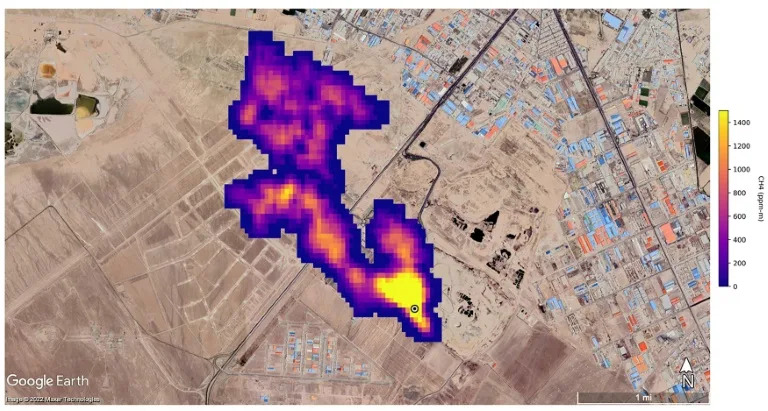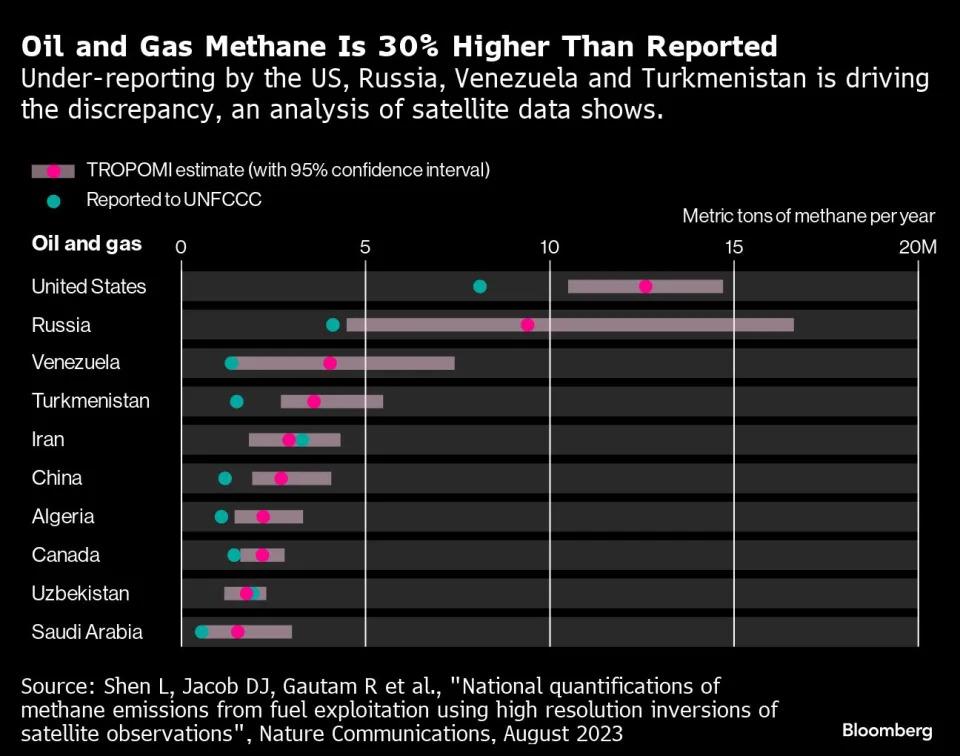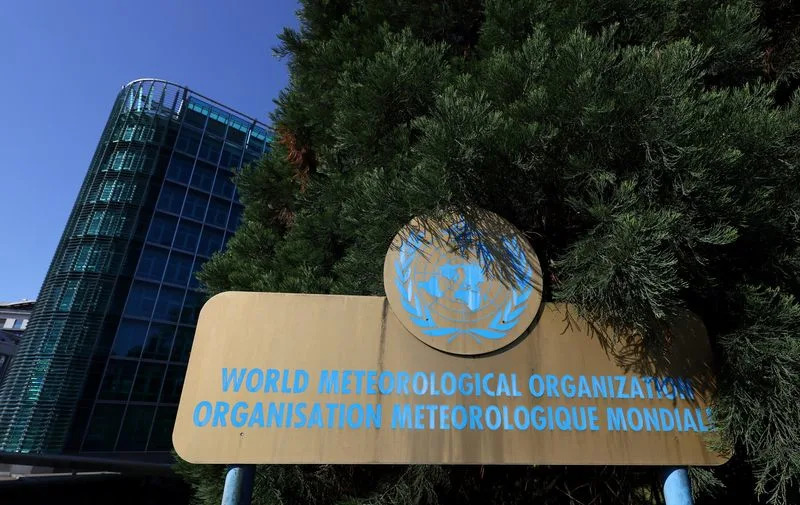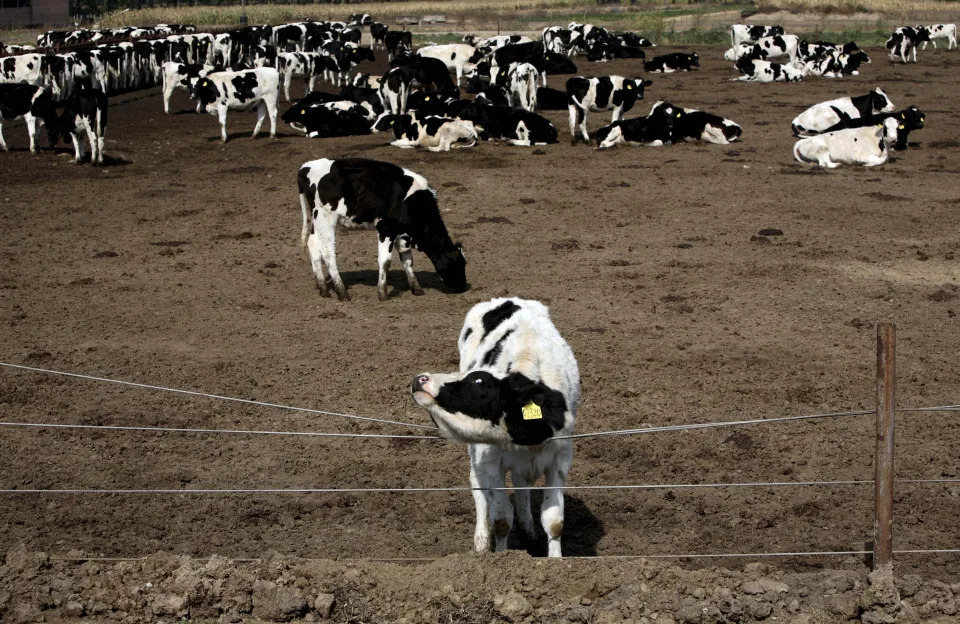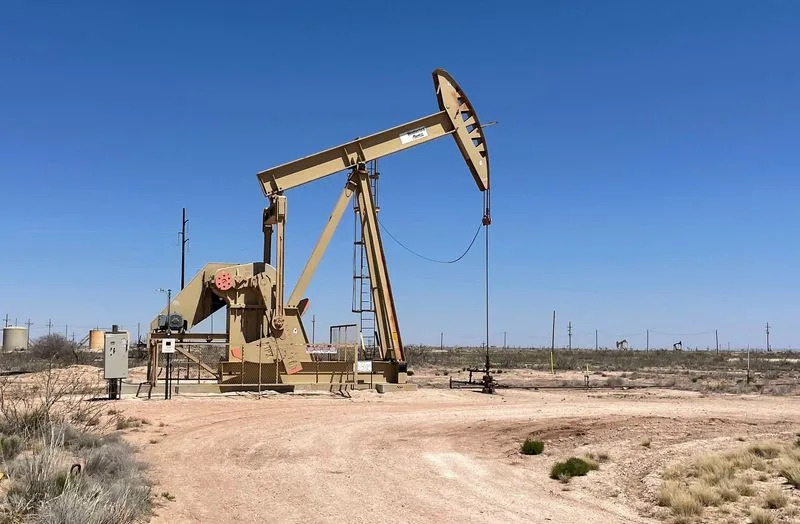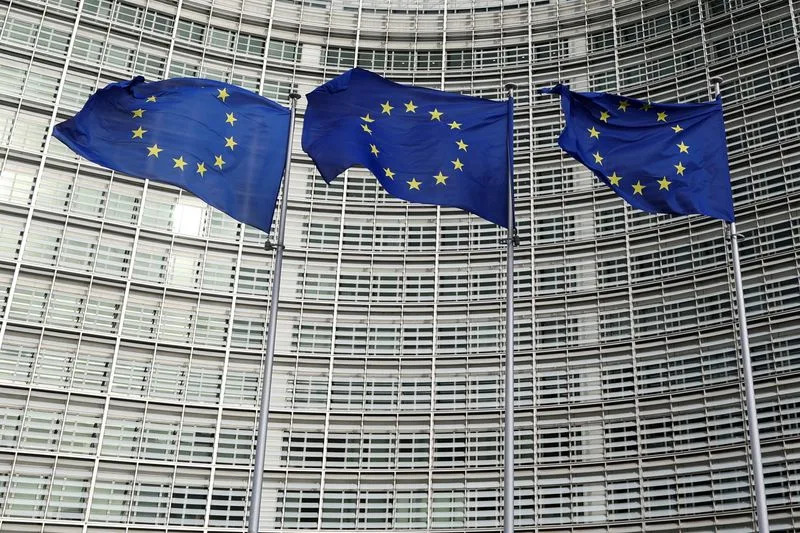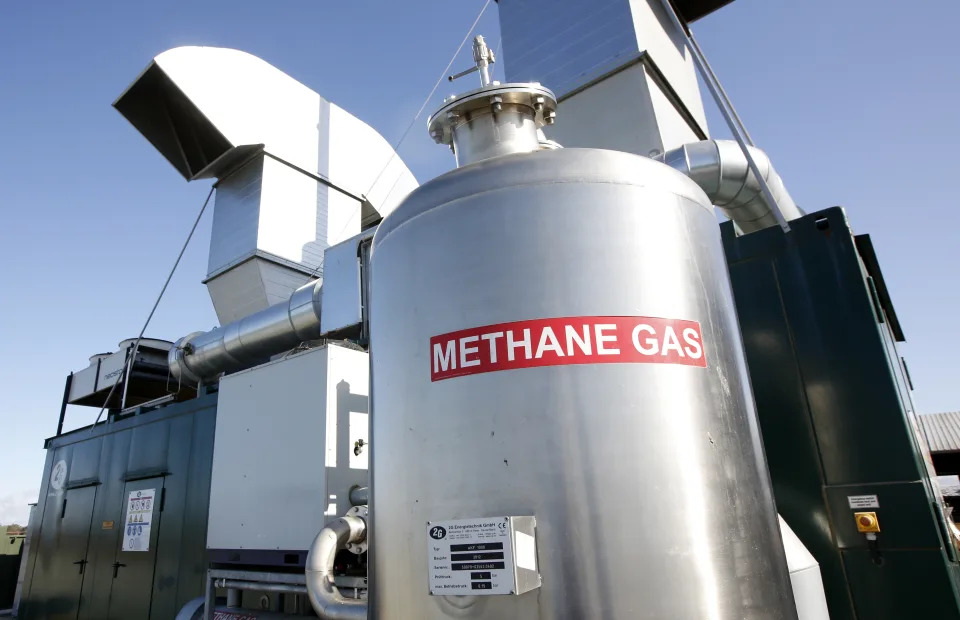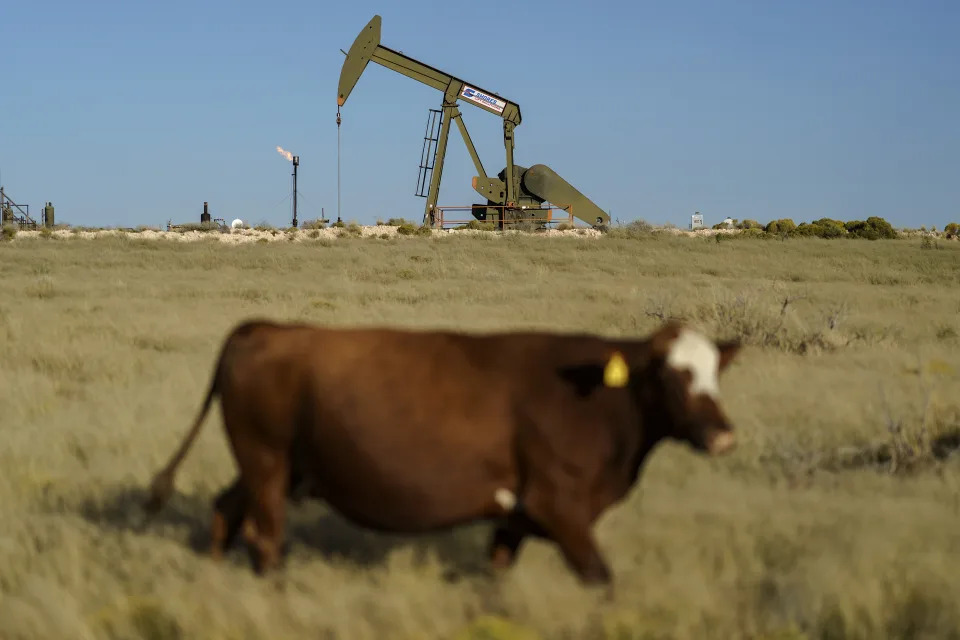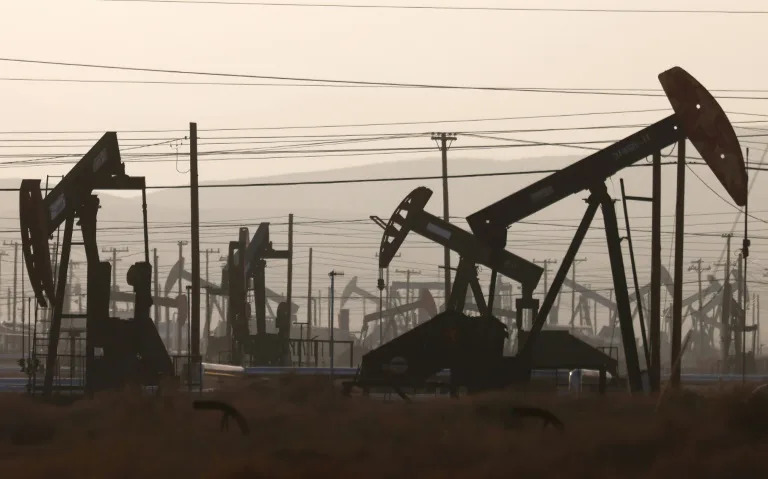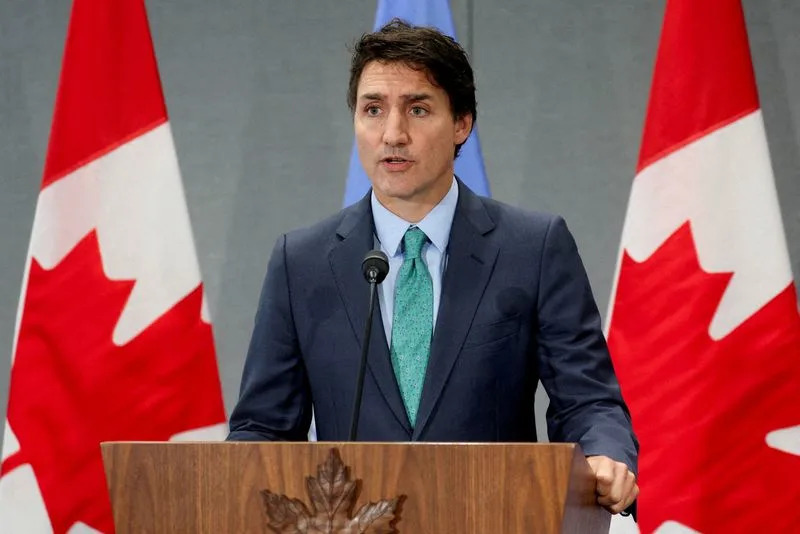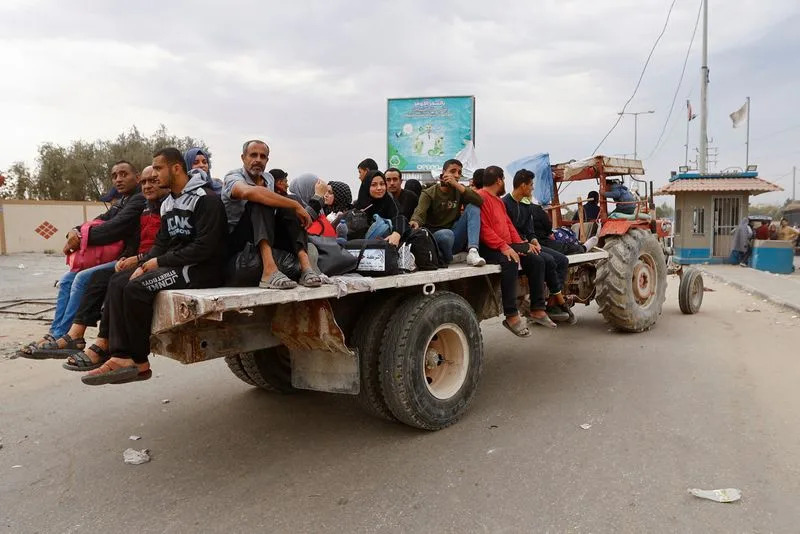Erin L. Meyer-Gutbrod, University of South Carolina;
Douglas Nowacek, Duke University;
Eileen E. Hofmann, Old Dominion University,
Josh Kohut, Rutgers University
Wed, November 15, 2023

Map of the Nantucket Shoals region, showing current wind-power lease areas (colored zones) and water depth contours (red and white lines) in meters.
Why are North Atlantic right whales of special concern?
North Atlantic right whales are critically endangered. Scientists estimate that the population is down to just 356 animals.
This species was almost driven to extinction after centuries of commercial whaling. Even though the whales have been protected from whaling for almost 100 years, they are still accidentally killed when they are hit by vessels or become entangled in fishing gear. These two sources of mortality are responsible for most documented juvenile and adult right whale deaths over the past 25 years.
There are options for protecting them, such as slowing or rerouting boats, shortening the fishing season or even modifying fishing gear to make it more whale-safe. However, regulators need to know where the whales are going to be and when they’ll be there, so they can put those protections in place.
It’s usually hard to figure out where whales are – they have a large habitat and spend most of their time below the surface of the water, where observers can’t see them. Recently it’s gotten even harder, because climate change is causing whales to shift where and when they feed.
Currently, right whales are spending more time around the Nantucket Shoals region. This means scientists and managers need to make sure that wind energy development in the area is happening safely and that threats to whales in the area are reduced.
How might offshore wind farms affect right whales in the study area?
Right whales are filter feeders that consume huge quantities of tiny zooplankton. The whales need to find large, dense patches of zooplankton at appropriate water depths in order to feed. Altering waves, tides and currents in ways that affect where their prey are located could affect whale feeding or cause the whales to change foraging habitats.
We concluded that it is critical to consistently monitor right whales and their prey within and outside the region, because we don’t know whether wind development will cause an increase, a decrease or no change to their zooplankton prey. Consistent monitoring will allow managers to mitigate potential negative impacts on the whales.
Researchers will need to collect data during all phases of wind farm construction and operation and develop robust models to determine whether wind farms will affect prey availability for right whales in the study area. Even once they do this research, it will still be difficult to isolate potential impacts from wind farms.
There is a tremendous amount of both natural and human-driven variability and change in this region, including tides, seasonal changes in water temperature and long-term ocean warming driven by climate change. Climate-driven shifts in prey in distant regions, such as the Bay of Fundy or the Gulf of St. Lawrence, may also change how right whales use the Nantucket Shoals region.
Development of the first wind energy farms in the Nantucket Shoals region is a valuable opportunity to better understand hydrodynamic impacts of turbines on marine ecosystems. We expect that it will help guide future development of wind farms along the U.S. East Coast.

A 2022 assessment by the National Renewable Energy Laboratory estimated that fixed-bottom and floating offshore wind turbines could generate enough energy to cover three times the annual electricity consumption in the U.S. NREL
What are the most important knowledge gaps?
Few studies have been done to understand hydrodynamics around wind energy turbines, and those that exist focus on European offshore wind farms in the North Sea, where conditions are different from Nantucket Shoals. Large turbines of the size planned for the Nantucket Shoals region have not been built yet in U.S. waters.
Researchers have tried to model the hydrodynamic impacts of turbines, but their results don’t always agree with each other. There’s a need for more work to compare different types of models with each other, and with actual observations in the ocean, to make sure that they represent key processes like tides, stratification, turbulence and drag correctly.
The most accurate outputs will likely come from using a range of models. Oceanographers might start with models that predict what happens as water moves past a single turbine. These results then would inform models that predict the effects of an entire wind farm. Then results from wind farm-scale models would be incorporated into models that predict regional ocean circulation.
There are also a lot of knowledge gaps on the biology side, including questions about what species of zooplankton are in the Nantucket Shoals region, where they come from and what makes them aggregate into patches that are dense enough for right whales to eat. Right whale feeding in the Nantucket Shoals region isn’t well understood, so scientists need more observations to determine which zooplankton types are targeted by right whales and where and when the whales feed.
Does the report call for slowing offshore wind development until these questions are answered?
No, and we were not asked to provide recommendations for how the wind industry should proceed with construction.
Nantucket Shoals is one of many regions where large-scale wind farms will be built in U.S. waters over the coming decades. Our committee advised federal regulators and other relevant organizations to conduct observational and modeling research to better understand hydrodynamic and ecological processes before, during and after wind farm construction. These studies will be critical for understanding and addressing environmental impacts from offshore wind farm development.
Richard Merrick, former chief science adviser and director of scientific programs at National Oceanic and Atmospheric Administration Fisheries, and Kelly Oskvig, National Academies of Sciences, Engineering, and Medicine director of the study described here, contributed to this article.
This article is republished from The Conversation, a nonprofit, independent news organization bringing you facts and analysis to help you make sense of our complex world.
It was written by: Erin L. Meyer-Gutbrod, University of South Carolina; Douglas Nowacek, Duke University; Eileen E. Hofmann, Old Dominion University, and Josh Kohut, Rutgers University.
Read more:
Lobsters versus right whales: The latest chapter in a long quest to make fishing more sustainable
The US just set ambitious offshore wind power targets – what will it take to meet them?
Erin L. Meyer-Gutbrod receives funding from the Bureau of Ocean Energy Management. She serves as a volunteer on the Marine Mammal Subcommittee of the Regional Wildlife Science Collaborative for Offshore Wind.
Douglas Nowacek receives funding from the U.S. Department of Energy and the Bureau of Ocean Energy Management.
Eileen E. Hofmann receives funding from the Bureau of Ocean Energy Management.
Josh Kohut receives funding from the U.S. Department of Energy. He serves as a volunteer member of the board of directors for the Marine Technology Society.
UK
Price paid for offshore power to rise by 50%
Simon Jack - Business editor
Wed, November 15, 2023 at

Offshore wind turbines
The price paid to generate electricity by offshore wind farms is set to rise by more than 50% as the government tries to entice energy firms to invest.
Its comes after an auction for offshore wind projects failed to attract any bids, with firms arguing the price set for electricity generated was too low.
The BBC understands the government now will raise the price it pays from £44 per MWh to as much as £70.
It is hoped more offshore wind capacity will lead to cheaper energy bills.
Energy companies have told the BBC that electricity produced out at sea would remain cheaper and less prone to shock increases compared to power derived from gas-fired power stations.
The UK is a world leader in offshore wind and is home to the world's four largest farms, supporting tens of thousands of jobs, which provided 13.8% of the UK's electricity generation last year, according to government statistics.
But when the government revealed in September that no companies bid for project contracts, plans to nearly quadruple offshore wind capacity from 13 gigawatts GW to 50 by 2030 - enough to power every home in the UK - were dealt a heavy blow.
The technology has been described as the "jewel in the UK's renewable energy crown", but firms have been hit by higher costs for building offshore farms, with materials such as steel and labour being more expensive.
According to energy companies, the government's failure to recognise the impact of higher costs led some firms to abandon existing projects, and all operators to boycott the most recent auction.
Why is the government paying energy firms?
The way the price guarantee between the government and energy companies works is that when market prices are lower than the set (or "strike") price, the government makes up the difference.
When they are above the strike price, the generators pay the extra cash back to the government.
But the price paid is only one part of the equation. The other is amount of electricity which the government will ensure is sold at a guaranteed price.
Industry sources have told the BBC that to make up for lost time this year and to hit its 2030 target, the government will need to attract bids for six to eight gigawatts of power every year for the next five years.
There is another huge problem in how the power produced out at sea is transported back to land. Hundreds of miles of pylons and underground cables will be required, many of which would, if built, cross privately-owned land.
The BBC understands Chancellor Jeremy Hunt will use his Autumn Statement to find ways to speed up this process by reclassifying such connections as critical national infrastructure, while also consulting on ways to compensate affected communities - including farmers - by offering discounts on energy bills.
"A combination of stick and carrot," as one industry source described it. "We can't continue to let small wealthy communities block energy developments for poorer but larger communities."
The measures will be part of a broader government ratification of an energy review conducted by the UK's electricity networks commissioner, Nick Winser, which laid out a series of recommendations to accelerate the connection of new power sources to the National Grid.
It is understood that the problem was thrown into very sharp relief when ministers were told that under current rules, a planned battery plant in Somerset might have to wait more than a decade to get connected to the electricity network.
August Graham, PA Business Reporter
Wed, November 15, 2023
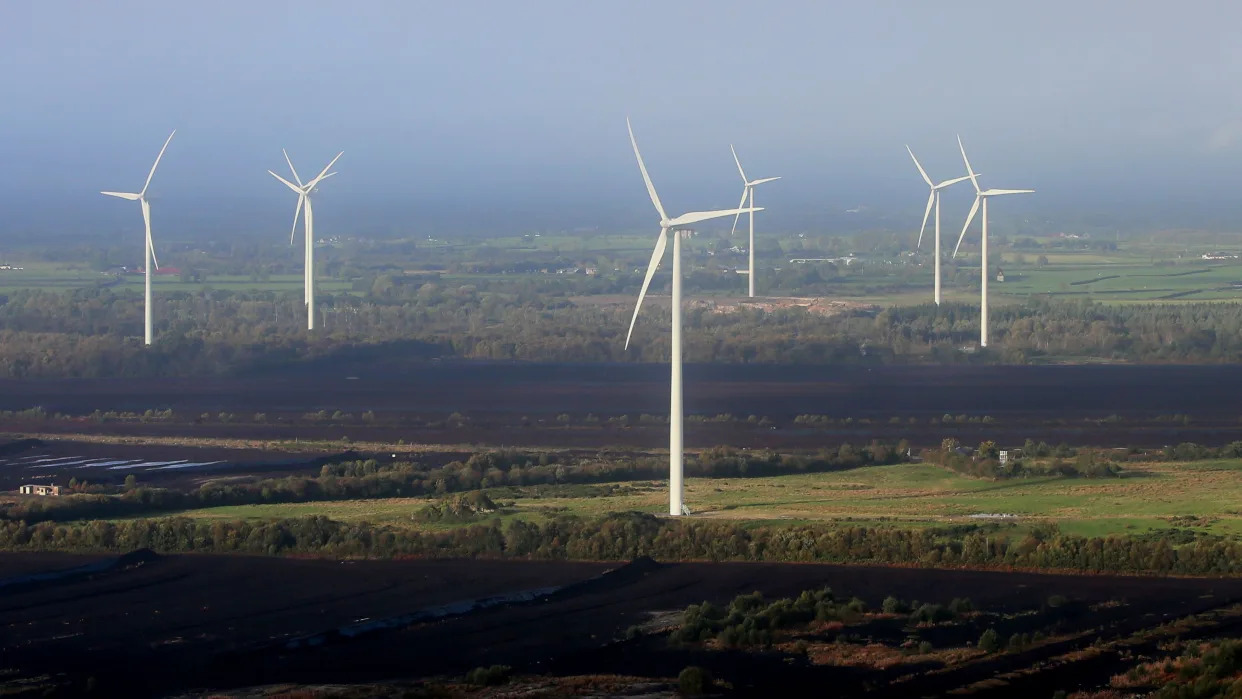
Energy company SSE doubled down on its outlook for the year even as poor weather conditions and delays to a wind farm hit power production at the company’s renewables arm.
SSE said it has seen a big drop in production from its onshore wind farms, down from 1.2 terawatt hours (TWh) in the first six months of last year to 788 gigawatt hours (GWh).
It was not enough to offset a big rise in the electricity coming from the company’s offshore wind turbines, as it brought more turbines online during the period.
SSE said “unfavourable weather conditions” had led “to a shortfall against planned output”.
It also had to deal with delays at the Seagreen wind farm off the coast of Angus in Scotland, meaning that total production was around planned levels.
That wind farm is now fully operational so, should the weather conditions be normal for the rest of the year, production will recover, SSE said.
Despite the drop-off in production, the renewables arm benefited from higher prices in its hedges – buying power in advance – with reported operating losses narrowing from £36.8 million to £23.7 million in the period.
It added to profits of £287.3 million at its electricity transmission arm and £120.1 million at the distribution arm, which run electricity grids.
The thermal and gas storage arm, which operate gas-powered electricity plants, recorded a profit of £143.3 million.
Overall the company swung from a pre-tax loss of £511 million to a £573.3 million profit.
Chief executive Alistair Phillips-Davies said: “Our performance in the first half of 2023/24 demonstrates SSE’s well-balanced business mix and our ability to adapt and create value while maintaining capital discipline in a fast-evolving energy landscape.
“With an enduring broad political consensus behind the need to build the electricity infrastructure required for net zero, a supportive power price outlook, balance sheet strength underpinned by world-class assets and unrivalled optionality across the clean energy value chain, we have increased confidence in our earnings forecasts not only for this year, but out to 2026/27.”
THE CONVERSATION

A row of monopiles that will be the base for offshore wind turbines, in the Atlantic Ocean off the coast of Martha's Vineyard, Mass.

A row of monopiles that will be the base for offshore wind turbines, in the Atlantic Ocean off the coast of Martha's Vineyard, Mass.
David L Ryan/The Boston Globe via Getty Images
As renewable energy production expands across the U.S., the environmental impacts of these new sources are receiving increased attention. In a recent report, the National Academies of Sciences, Engineering, and Medicine examined whether and how constructing offshore wind farms in the Nantucket Shoals region, southeast of Massachusetts, could affect critically endangered North Atlantic right whales. The Conversation asked marine scientists Erin L. Meyer-Gutbrod, Douglas Nowacek, Eileen E. Hofmann and Josh Kohut, all of whom served on the study committee, to explain the report’s key findings.
Why did this study focus on such a specific site?
The Bureau of Ocean Energy Management, which is part of the U.S. Department of the Interior and regulates offshore energy production, asked the National Academies to conduct this study. Regulators wanted to better understand how installing and operating offshore, fixed-bottom wind turbine generators would affect physical oceanographic processes, such as tides, waves and currents, and in turn how those changes could affect the ecosystem.
For example, offshore wind turbines decrease wind speeds behind them, and the presence of their structures makes the water more turbulent. These changes could affect ocean currents, surface wind speeds and other factors that influence hydrodynamics – the structure and movement of the water around the turbines.
The Nantucket Shoals region is a large, shallow area in the Atlantic that extends south of Cape Cod. Our report focused on it because this is the first large-scale offshore wind farm area in the U.S., and the region has been included in several recent hydrodynamic modeling studies.
As renewable energy production expands across the U.S., the environmental impacts of these new sources are receiving increased attention. In a recent report, the National Academies of Sciences, Engineering, and Medicine examined whether and how constructing offshore wind farms in the Nantucket Shoals region, southeast of Massachusetts, could affect critically endangered North Atlantic right whales. The Conversation asked marine scientists Erin L. Meyer-Gutbrod, Douglas Nowacek, Eileen E. Hofmann and Josh Kohut, all of whom served on the study committee, to explain the report’s key findings.
Why did this study focus on such a specific site?
The Bureau of Ocean Energy Management, which is part of the U.S. Department of the Interior and regulates offshore energy production, asked the National Academies to conduct this study. Regulators wanted to better understand how installing and operating offshore, fixed-bottom wind turbine generators would affect physical oceanographic processes, such as tides, waves and currents, and in turn how those changes could affect the ecosystem.
For example, offshore wind turbines decrease wind speeds behind them, and the presence of their structures makes the water more turbulent. These changes could affect ocean currents, surface wind speeds and other factors that influence hydrodynamics – the structure and movement of the water around the turbines.
The Nantucket Shoals region is a large, shallow area in the Atlantic that extends south of Cape Cod. Our report focused on it because this is the first large-scale offshore wind farm area in the U.S., and the region has been included in several recent hydrodynamic modeling studies.

Map of the Nantucket Shoals region, showing current wind-power lease areas (colored zones) and water depth contours (red and white lines) in meters.
Why are North Atlantic right whales of special concern?
North Atlantic right whales are critically endangered. Scientists estimate that the population is down to just 356 animals.
This species was almost driven to extinction after centuries of commercial whaling. Even though the whales have been protected from whaling for almost 100 years, they are still accidentally killed when they are hit by vessels or become entangled in fishing gear. These two sources of mortality are responsible for most documented juvenile and adult right whale deaths over the past 25 years.
There are options for protecting them, such as slowing or rerouting boats, shortening the fishing season or even modifying fishing gear to make it more whale-safe. However, regulators need to know where the whales are going to be and when they’ll be there, so they can put those protections in place.
It’s usually hard to figure out where whales are – they have a large habitat and spend most of their time below the surface of the water, where observers can’t see them. Recently it’s gotten even harder, because climate change is causing whales to shift where and when they feed.
Currently, right whales are spending more time around the Nantucket Shoals region. This means scientists and managers need to make sure that wind energy development in the area is happening safely and that threats to whales in the area are reduced.
How might offshore wind farms affect right whales in the study area?
Right whales are filter feeders that consume huge quantities of tiny zooplankton. The whales need to find large, dense patches of zooplankton at appropriate water depths in order to feed. Altering waves, tides and currents in ways that affect where their prey are located could affect whale feeding or cause the whales to change foraging habitats.
We concluded that it is critical to consistently monitor right whales and their prey within and outside the region, because we don’t know whether wind development will cause an increase, a decrease or no change to their zooplankton prey. Consistent monitoring will allow managers to mitigate potential negative impacts on the whales.
Researchers will need to collect data during all phases of wind farm construction and operation and develop robust models to determine whether wind farms will affect prey availability for right whales in the study area. Even once they do this research, it will still be difficult to isolate potential impacts from wind farms.
There is a tremendous amount of both natural and human-driven variability and change in this region, including tides, seasonal changes in water temperature and long-term ocean warming driven by climate change. Climate-driven shifts in prey in distant regions, such as the Bay of Fundy or the Gulf of St. Lawrence, may also change how right whales use the Nantucket Shoals region.
Development of the first wind energy farms in the Nantucket Shoals region is a valuable opportunity to better understand hydrodynamic impacts of turbines on marine ecosystems. We expect that it will help guide future development of wind farms along the U.S. East Coast.

A 2022 assessment by the National Renewable Energy Laboratory estimated that fixed-bottom and floating offshore wind turbines could generate enough energy to cover three times the annual electricity consumption in the U.S. NREL
What are the most important knowledge gaps?
Few studies have been done to understand hydrodynamics around wind energy turbines, and those that exist focus on European offshore wind farms in the North Sea, where conditions are different from Nantucket Shoals. Large turbines of the size planned for the Nantucket Shoals region have not been built yet in U.S. waters.
Researchers have tried to model the hydrodynamic impacts of turbines, but their results don’t always agree with each other. There’s a need for more work to compare different types of models with each other, and with actual observations in the ocean, to make sure that they represent key processes like tides, stratification, turbulence and drag correctly.
The most accurate outputs will likely come from using a range of models. Oceanographers might start with models that predict what happens as water moves past a single turbine. These results then would inform models that predict the effects of an entire wind farm. Then results from wind farm-scale models would be incorporated into models that predict regional ocean circulation.
There are also a lot of knowledge gaps on the biology side, including questions about what species of zooplankton are in the Nantucket Shoals region, where they come from and what makes them aggregate into patches that are dense enough for right whales to eat. Right whale feeding in the Nantucket Shoals region isn’t well understood, so scientists need more observations to determine which zooplankton types are targeted by right whales and where and when the whales feed.
Does the report call for slowing offshore wind development until these questions are answered?
No, and we were not asked to provide recommendations for how the wind industry should proceed with construction.
Nantucket Shoals is one of many regions where large-scale wind farms will be built in U.S. waters over the coming decades. Our committee advised federal regulators and other relevant organizations to conduct observational and modeling research to better understand hydrodynamic and ecological processes before, during and after wind farm construction. These studies will be critical for understanding and addressing environmental impacts from offshore wind farm development.
Richard Merrick, former chief science adviser and director of scientific programs at National Oceanic and Atmospheric Administration Fisheries, and Kelly Oskvig, National Academies of Sciences, Engineering, and Medicine director of the study described here, contributed to this article.
This article is republished from The Conversation, a nonprofit, independent news organization bringing you facts and analysis to help you make sense of our complex world.
It was written by: Erin L. Meyer-Gutbrod, University of South Carolina; Douglas Nowacek, Duke University; Eileen E. Hofmann, Old Dominion University, and Josh Kohut, Rutgers University.
Read more:
Lobsters versus right whales: The latest chapter in a long quest to make fishing more sustainable
The US just set ambitious offshore wind power targets – what will it take to meet them?
Erin L. Meyer-Gutbrod receives funding from the Bureau of Ocean Energy Management. She serves as a volunteer on the Marine Mammal Subcommittee of the Regional Wildlife Science Collaborative for Offshore Wind.
Douglas Nowacek receives funding from the U.S. Department of Energy and the Bureau of Ocean Energy Management.
Eileen E. Hofmann receives funding from the Bureau of Ocean Energy Management.
Josh Kohut receives funding from the U.S. Department of Energy. He serves as a volunteer member of the board of directors for the Marine Technology Society.
UK
Price paid for offshore power to rise by 50%
Simon Jack - Business editor
Wed, November 15, 2023 at

Offshore wind turbines
The price paid to generate electricity by offshore wind farms is set to rise by more than 50% as the government tries to entice energy firms to invest.
Its comes after an auction for offshore wind projects failed to attract any bids, with firms arguing the price set for electricity generated was too low.
The BBC understands the government now will raise the price it pays from £44 per MWh to as much as £70.
It is hoped more offshore wind capacity will lead to cheaper energy bills.
Energy companies have told the BBC that electricity produced out at sea would remain cheaper and less prone to shock increases compared to power derived from gas-fired power stations.
The UK is a world leader in offshore wind and is home to the world's four largest farms, supporting tens of thousands of jobs, which provided 13.8% of the UK's electricity generation last year, according to government statistics.
But when the government revealed in September that no companies bid for project contracts, plans to nearly quadruple offshore wind capacity from 13 gigawatts GW to 50 by 2030 - enough to power every home in the UK - were dealt a heavy blow.
The technology has been described as the "jewel in the UK's renewable energy crown", but firms have been hit by higher costs for building offshore farms, with materials such as steel and labour being more expensive.
According to energy companies, the government's failure to recognise the impact of higher costs led some firms to abandon existing projects, and all operators to boycott the most recent auction.
Why is the government paying energy firms?
The way the price guarantee between the government and energy companies works is that when market prices are lower than the set (or "strike") price, the government makes up the difference.
When they are above the strike price, the generators pay the extra cash back to the government.
But the price paid is only one part of the equation. The other is amount of electricity which the government will ensure is sold at a guaranteed price.
Industry sources have told the BBC that to make up for lost time this year and to hit its 2030 target, the government will need to attract bids for six to eight gigawatts of power every year for the next five years.
There is another huge problem in how the power produced out at sea is transported back to land. Hundreds of miles of pylons and underground cables will be required, many of which would, if built, cross privately-owned land.
The BBC understands Chancellor Jeremy Hunt will use his Autumn Statement to find ways to speed up this process by reclassifying such connections as critical national infrastructure, while also consulting on ways to compensate affected communities - including farmers - by offering discounts on energy bills.
"A combination of stick and carrot," as one industry source described it. "We can't continue to let small wealthy communities block energy developments for poorer but larger communities."
The measures will be part of a broader government ratification of an energy review conducted by the UK's electricity networks commissioner, Nick Winser, which laid out a series of recommendations to accelerate the connection of new power sources to the National Grid.
It is understood that the problem was thrown into very sharp relief when ministers were told that under current rules, a planned battery plant in Somerset might have to wait more than a decade to get connected to the electricity network.
‘Unfavourable’ weather hits wind power production at SSE
August Graham, PA Business Reporter
Wed, November 15, 2023

Energy company SSE doubled down on its outlook for the year even as poor weather conditions and delays to a wind farm hit power production at the company’s renewables arm.
SSE said it has seen a big drop in production from its onshore wind farms, down from 1.2 terawatt hours (TWh) in the first six months of last year to 788 gigawatt hours (GWh).
It was not enough to offset a big rise in the electricity coming from the company’s offshore wind turbines, as it brought more turbines online during the period.
SSE said “unfavourable weather conditions” had led “to a shortfall against planned output”.
It also had to deal with delays at the Seagreen wind farm off the coast of Angus in Scotland, meaning that total production was around planned levels.
That wind farm is now fully operational so, should the weather conditions be normal for the rest of the year, production will recover, SSE said.
Despite the drop-off in production, the renewables arm benefited from higher prices in its hedges – buying power in advance – with reported operating losses narrowing from £36.8 million to £23.7 million in the period.
It added to profits of £287.3 million at its electricity transmission arm and £120.1 million at the distribution arm, which run electricity grids.
The thermal and gas storage arm, which operate gas-powered electricity plants, recorded a profit of £143.3 million.
Overall the company swung from a pre-tax loss of £511 million to a £573.3 million profit.
Chief executive Alistair Phillips-Davies said: “Our performance in the first half of 2023/24 demonstrates SSE’s well-balanced business mix and our ability to adapt and create value while maintaining capital discipline in a fast-evolving energy landscape.
“With an enduring broad political consensus behind the need to build the electricity infrastructure required for net zero, a supportive power price outlook, balance sheet strength underpinned by world-class assets and unrivalled optionality across the clean energy value chain, we have increased confidence in our earnings forecasts not only for this year, but out to 2026/27.”
